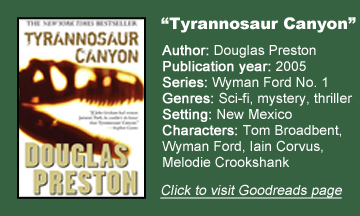Novels where dinosaurs roam present-day Earth were left to the late, great Michael Crichton, and that’s as it should be, but Douglas Preston crafts an outstanding book with a T-rex as the absent center: “Tyrannosaur Canyon” (2005).
Italicized segments evocatively describe the way the T-rex operated like a machine, with a brain nearly the size of a human’s but entirely devoted to killing and consuming meat; no long-term memory distracts her.
Adventure for the eons
This gives “Tyrannosaur Canyon,” Preston’s third solo novel, heft across the eons. Also bringing the T-rex metaphorically back to life are the many different people seeking a full fossil skeleton in the New Mexico badlands, for varied but related reasons.
Even a contract killer, Maddox, has a T-rex tattoo on his back: In a scene that could be silly but turns out effectively creepy, he flexes his back muscles in lantern light, giving the inked rex the illusion of roaring and clawing.
The fossil is in Bureau of Land Management territory – coincidentally in the titular canyon — meaning only institutions can lay claim to it with a permit, but on the black market it could sell for $180 million.
This is a vast, incompletely mapped land where illegal fossil hunters roam. So we get the thrill of a treasure hunt, plus all the other requisite Southwest tropes that Preston could write in his sleep at this point: chases through canyons, mesas and buttes; terrifyingly claustrophobic tunnels; thirsty desert travelers; and Anasazi ruins. And the author gives an Easter egg to “Mount Dragon” fans at the end.
Broadbents return, Ford debuts
The stars of the New Mexico segments are Tom and Sally Broadbent (both from “The Codex”) , who hold the fossil-hunter’s journal that several parties seek, and Wyman Ford (later to be Preston’s go-to protagonist), a prospective monk who is trying to recover from the CIA career that killed his wife.
I was surprised to find Ford described as physically ugly in this book, since he’s the hero of future books and that trait is downplayed if it’s mentioned at all.
But I most enjoyed the New York scenes, featuring Dr. Corvis and lab specialist Melodie Crookshank. For some reason, Preston calls their place of work the American Museum of Natural History rather than the New York Museum of Natural History (the name of the museum in the Preston & Child books that’s based on the real-life American Museum of Natural History).
When Corvis is chased through a room and hides amid dinosaur fossils, it calls to mind “Relic” and “The Cabinet of Curiosities.” So does Melodie’s work with a sample of T-rex bone, alone in her basement lab. Unfortunately, the change in the museum’s name holds me back from completely making the connection.
Corvis and Melodie are two sides of a coin in Preston’s portrayal of career advancement in science, with Corvis aiming to obtain the fossil at all costs and the underappreciated Melodie simply paying her dues as a lab worker. Preston writes a delicious outcome for Melodie; this book would mark the origin story of a superstar scientist if he wants to use her in future novels.

Preston writes the clashes between Maddox and kidnap victim Sally with such effectiveness that I almost found them hard to read, including her particularly desperate spelunking that reminded me of the movie “The Descent.”
Dino mysteries aren’t extinct
So I found the scientific mysteries back at the NYC museum to be refreshing distractions. But what’s more, that dino bone sample holds stakes for the human race – not only for our collective knowledge, but also for humanity’s fate, since a secret government agency wants to weaponize something found in the dinosaur.
Preston is theorizing about dinosaur extinction and behavior – like Crichton does in “The Lost World” – but he backs it up with fascinating science. It’s all the more impressive since this isn’t a case of a T-rex being cloned and observed, but rather of Melodie looking at slides under a microscope.
As the author works his theories into the narrative, I learned a lot about the Yucatan asteroid from 65 million years ago and what a related pandemic would be like. He draws from nonfiction dinosaur books, which he references in the text and afterword.
Although “Relic’s” Mbwun beast is almost a dinosaur, “Tyrannosaur Canyon” is the first work of fiction where Preston writes about the prehistoric reptiles. His writings about New Mexico adventures and New York museum research are comparatively old hat, but he creates several strong characters and puts them on gripping journeys that expertly interlock.
The book has the urgency of a “Jurassic Park”-ian T-rex chase, paired with a scientific mystery we can sink our teeth into.


